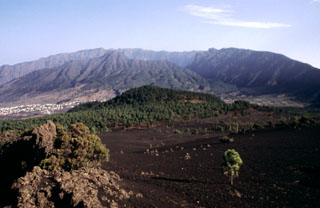Report on La Palma (Spain) — 10 November-16 November 2021
Smithsonian Institution / US Geological Survey
Weekly Volcanic Activity Report, 10 November-16 November 2021
Managing Editor: Sally Sennert.
Please cite this report as:
Global Volcanism Program, 2021. Report on La Palma (Spain) (Sennert, S, ed.). Weekly Volcanic Activity Report, 10 November-16 November 2021. Smithsonian Institution and US Geological Survey.
La Palma
Spain
28.57°N, 17.83°W; summit elev. 2426 m
All times are local (unless otherwise noted)
The eruption at La Palma continued during 10-16 November, characterized by Strombolian explosions and lava fountaining from multiple vents, advancing and sometimes branching lava flows, and daily ash emissions. Eruption details are based on official sources including daily PEVOLCA (Plan de Emergencias Volcánicas de Canarias) steering committee summaries. Volcanic tremor levels continued to be low. Seismicity at intermediate depths of 10-15 km remained low compared to previous weeks. The number and magnitude of deeper events, 20-38 km deep, increased during 9-11 with the highest number of deeper events recorded since the beginning of the eruption; the rate of deeper events decreased during 11-12 November. Two M 5 earthquakes were the largest events recorded during the week, occurring at 0447 on 11 November at a depth of 30 km and at 0756 on 13 November at a depth of 38 km.
Several vents in the main cone continued to effuse lava, eject tephra, and emit ash-and-gas plumes. The activity levels varied in intensity, though decreased overall during the week. By 10 November the highest point of the main cone was 1,130 m a.s.l. Lava continued to flow west through pre-existing lava channels and tubes, over older flows, and occasionally formed new branches. Occasional short-lived overflows of lava ponds occurred at the main crater vents. The flow field was made up of overlapping flows numbered 1-11. Lava filled in some gaps between the N flows, numbers 4 and 7, though lava-flow advancement was mainly focused at and near the ocean entries, with lava feeding flows 1, 2, and 9. The first flow, number 1, had previously reached the sea, and flow 9 had stalled before reaching the coast. Flow number 2 (in between 1 and 9) had reached the sea at Los Guirres Beach on 9 November, and sent a new branch N that entered the ocean at 0144 on 10 November. Flow 2 continued to advance during the week, filling in gaps between flows 1 and 9, and adding to the new lava delta laterally. Areas of high turbidity in the water column as far as 1 km from the lava front were caused by underwater lava advancement. By 16 November the width of the flow field had grown to 3.2 km.
Sulfur dioxide emissions fluctuated at high levels between 7,000 and 43,000 tons per day on most days, but was as low as 2,000-4,000 tons per day on 13 and 15 November. Sometimes dense and billowing ash-and-gas plumes rose 1.8-3.1 km (5,900-10,200 ft) a.s.l. and drifted in multiple directions. Ash emissions intensified on 14 November. Clean-up of ash from streets and homes was conducted by both authorities and residents. According to a news report a resident that was granted permission to enter the exclusion zone to clean ash off of his roof died in the neighborhood of Corazoncillo of unknown causes. Fresh ash emissions from the volcano, and ash resuspended by people and vehicle movements, triggered a few air-quality alerts issued during 14-16 November; authorities warned residents of some affected areas (Los Llanos de Aridane, Tazacorte, El Paso, Puntagorda, and Tijarafe) to stay indoors. On 16 November ash drifted W and SW and caused some flight disruptions at the La Palma airport.
Geological Summary. The 47-km-long wedge-shaped island of La Palma, the NW-most of the Canary Islands, is composed of two large volcanic centers. The older northern one is cut by the steep-walled Caldera Taburiente, one of several massive collapse scarps produced by edifice failure to the SW. On the south, the younger Cumbre Vieja volcano is one of the most active in the Canaries. The elongated volcano dates back to about 125,000 years ago and is oriented N-S. Eruptions during the past 7,000 years have formed abundant cinder cones and craters along the axis, producing fissure-fed lava flows that descend steeply to the sea. Eruptions recorded since the 15th century have produced mild explosive activity and lava flows that damaged populated areas. The southern tip of the island is mantled by a broad lava field emplaced during the 1677-1678 eruption. Lava flows also reached the sea in 1585, 1646, 1712, 1949, 1971, and 2021.
Sources: Instituto Volcanológico de Canarias (INVOLCAN), Instituto Geográfico Nacional (IGN), Gobierno de Canaries, EL PAÍS

